Global Sun Technology GL2411RT-0B Access Point User Manual GL2411RT 0B 4
Global Sun Technology Inc Access Point GL2411RT 0B 4
Contents
- 1. Users Manual Part 1
- 2. Users Manual Part 2
- 3. DoC Statement
- 4. Users Manual Part 3 revised
Users Manual Part 3 revised
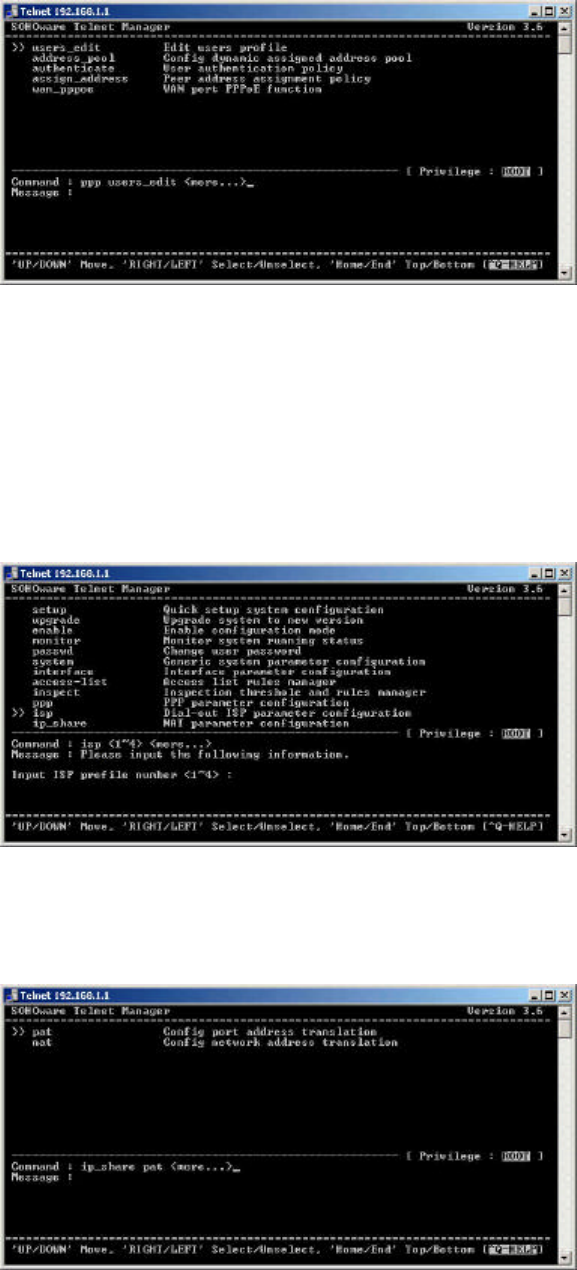
41
Hit “Enter” on PPP and you can setup the following:
Users_edit – Edit users profile.
Address_pool – Config dynamic assigned address pool.
Authenticate – User authentication policy.
Assign_address – Peer address assignment policy.
Wan_pppoe – WAN port PPPoE function.
ISP
Hit “Enter” on ISP and you will prompt to input the ISP profile number.
IP_share
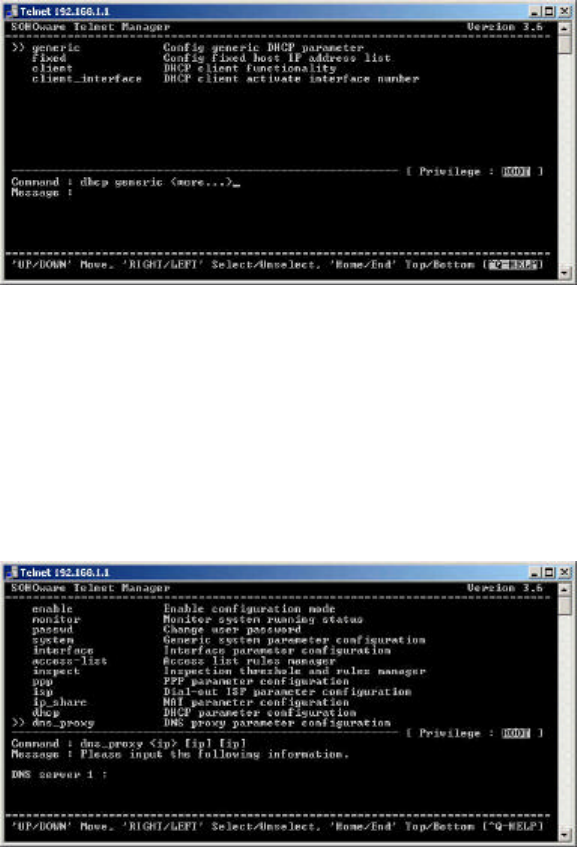
42
Hit “Enter” on Ip_share and you can setup the following:
Pat – Config port address translation.
Nat – Config network address translation.
DHCP
Hit “Enter” on DHCP and you can setup the following:
Generic – Configure generic DHCP parameter.
Fixed – Configure Fixed host IP address list.
Client – DHCP client functionality.
Client_interface – DHCP client activate interface number.
DNS Proxy
Hit “Enter” on DNS Proxy and you can setup DNS_proxy server name and its IP address.
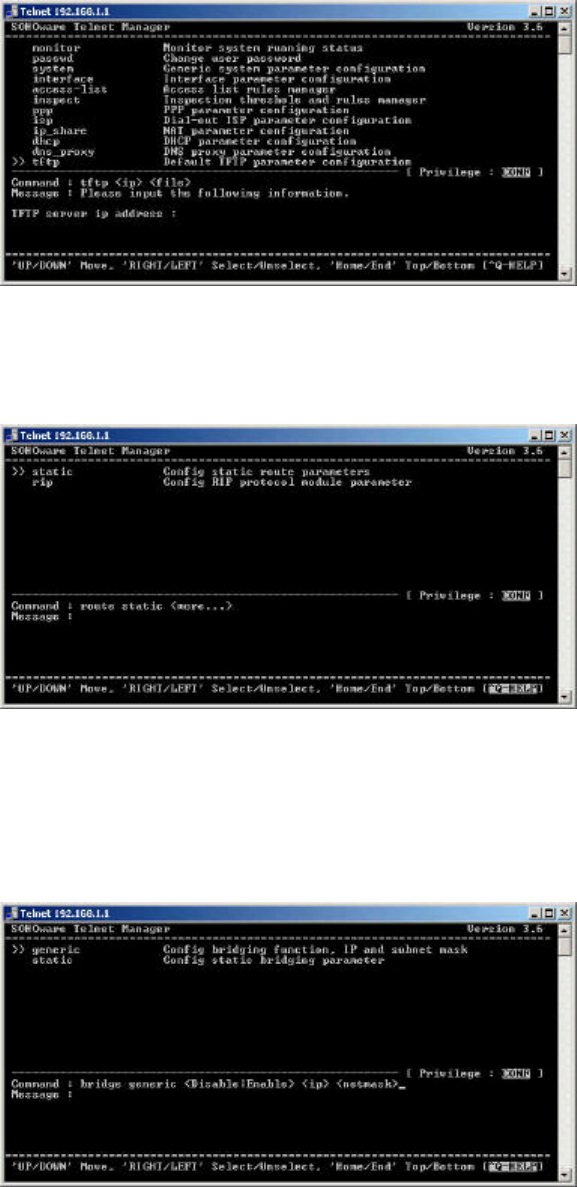
43
Tftp
Hit “Enter” on Tftp and you can setup the IP address for Tftp server.
Route
Hit “Enter” on Route and you can setup
Static – To configure the static route parameters.
Rip – To configure RIP protocol module parameter.
Bridge
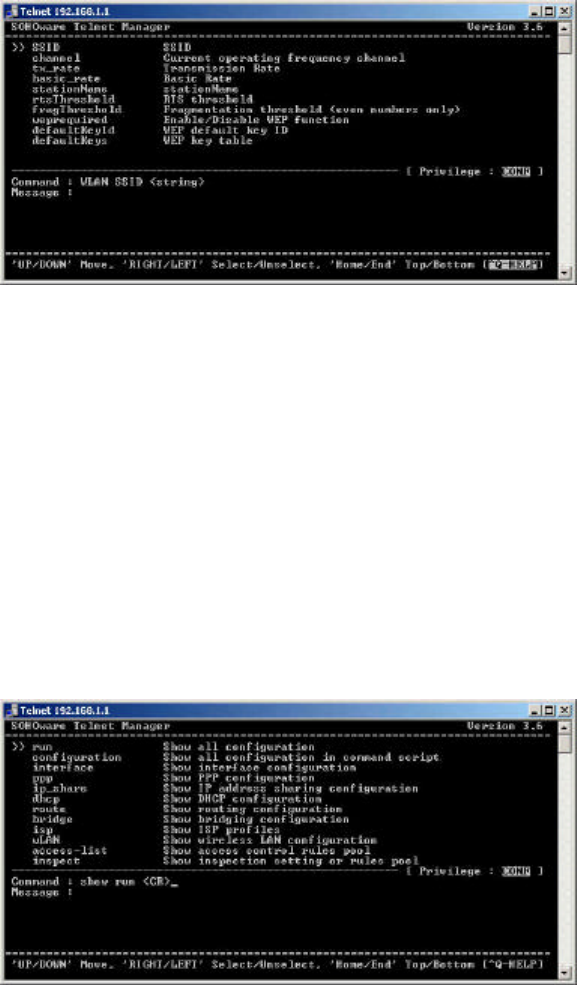
44
Hit “Enter” on Bridge you can setup
Generic – To configure bridging function, IP and subnet mask.
Static – To configure static bridging parameter.
WLAN
Hit “Enter” you are able to configure,
SSID
Channel – Current operating frequency channel.
Tx_rate – Transmission Rate
Basic_rate – Basic rate.
Station name – station name
Rts Threshold – Rtx threshold.
FragThreshold – Fragmentation threshold (even numbers only)
Weprequired – Enable/Disable WEP function.
DefaultKeyID – WEP default key ID.
DefaultKeys – WEP key table.
Show
Hit “Enter” on Show you may be able to view
Run – Show all configuration.
Configuration – Show all configuration in command script
Interface – Show interface configuration.
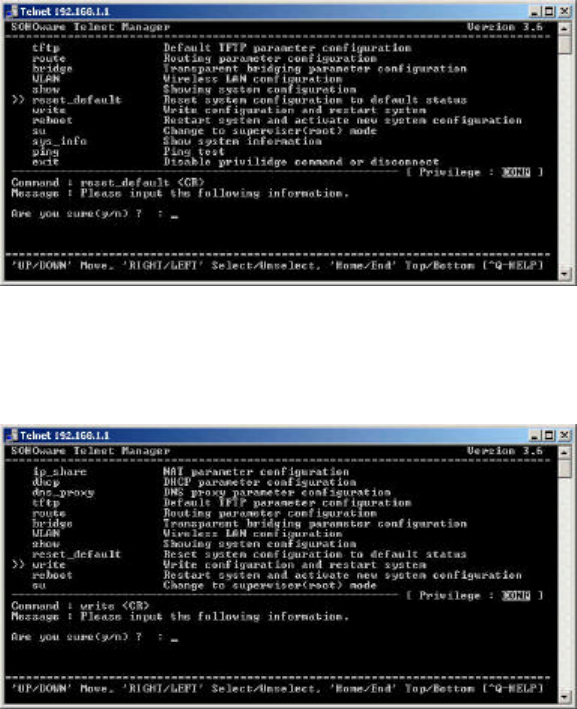
45
PPP – Show PPP configuration.
IP_share – Show IP address sharing configuration.
DHCP – Show DHCP configuration.
Route – Show routing configuration
Bridge – Show bridging configuration.
ISP – Show ISP profiles.
WLAN – Show wireless LAN configuration.
Access-List – Show access control rules pool.
Inspect – Show inspection setting or rules pool.
Reset_Default
Hit “Enter” on reset_default and type “y” for yes and “n” for no to reset to default
setting.
Write
Hit “Enter” on Write and type “y” for yes and “n” for no to reset the system
configuration to default status.
Reboot
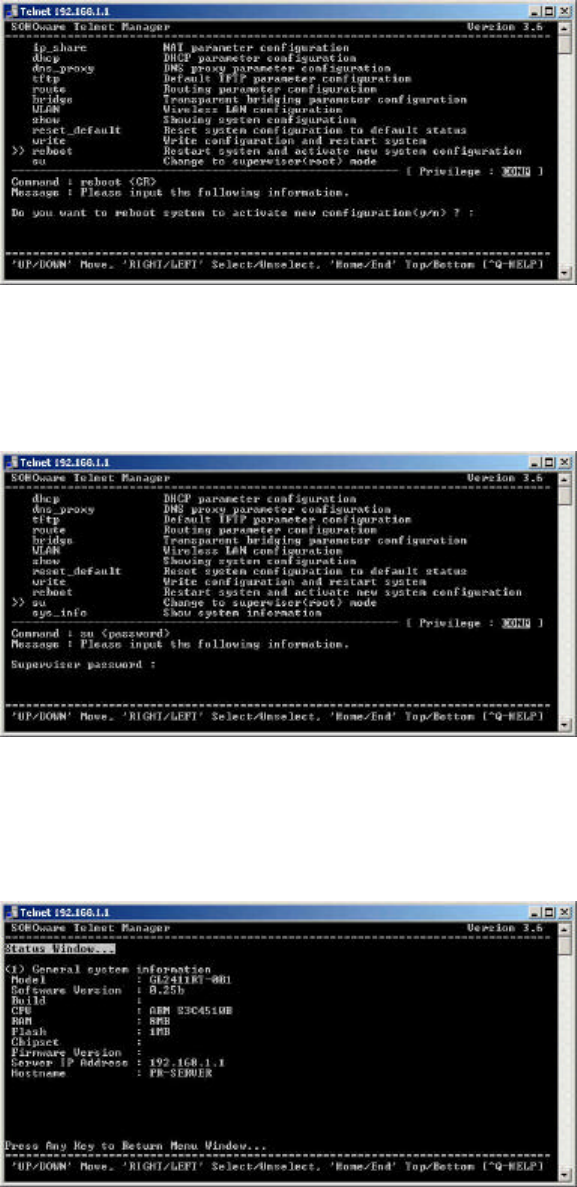
46
Hit “Enter” on reboot and type “y” for yes and “n” for no to restart system and activate
new system configuration.
Su
Hit “Enter” on su to switch to supervisor mode, it will prompt you for supervisor
password.
Sys_info
Hit “Enter” on sys_info and it will take you to a status screen.
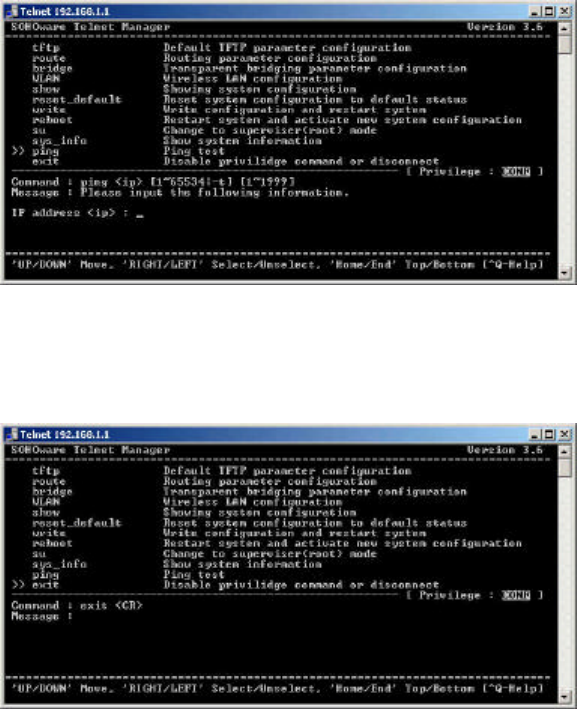
47
Ping
Hit “Enter” on ping and it will prompt you for a IP address to ping to.
Exit
Hit “Enter” on exit to disable privileged command or disconnect.
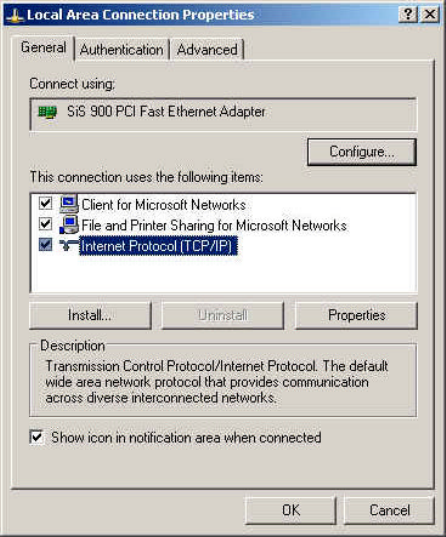
48
Section 6 How to Configure Your PC to Connect the
Gateway Router
If you do not wish to set a static IP address on your PC, you will need to configure your
PC to accept the IP address that your gateway will provide.
1. Click Start button, select Settings, then Control Panel
2. Double-click the Network Icon
3. In the configuration windows, select the Internet Protocol that has been associated
with your network card/adapter. If there is no TCP/IP line listed, you will need to
install the TCP/IP now.
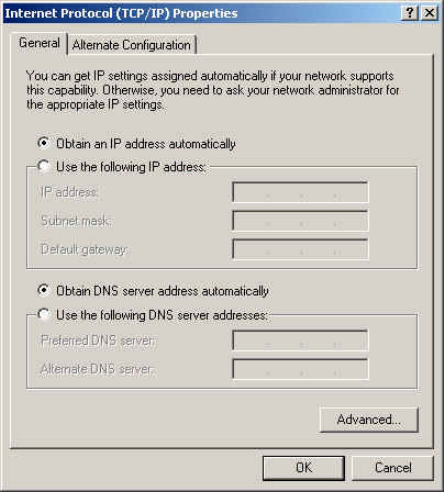
49
4. Click the Properties button, then choose the IP ADDRESS tab. Select Obtain an IP
address automatically.
5. Then select DNS configuration tab to add DNS IP address. If you do not wish to
add DNS you can disable DNS function. Press OK. You have completed the client
settings.
6. After clicking OK, windows will ask you to restart the PC. Click Yes.
Confirm Your PC’s IP Configuration
There are two tools which are great for finding out a computer’s IP configuration: MAC
address and default gateway.
l WINIPCFG (for windows 95/98/ME)
Inside the windows 95/98/ME Start button, select Run and type winipcfg. In the
example below this computer has a IP address of 192.168.1.2 and the default
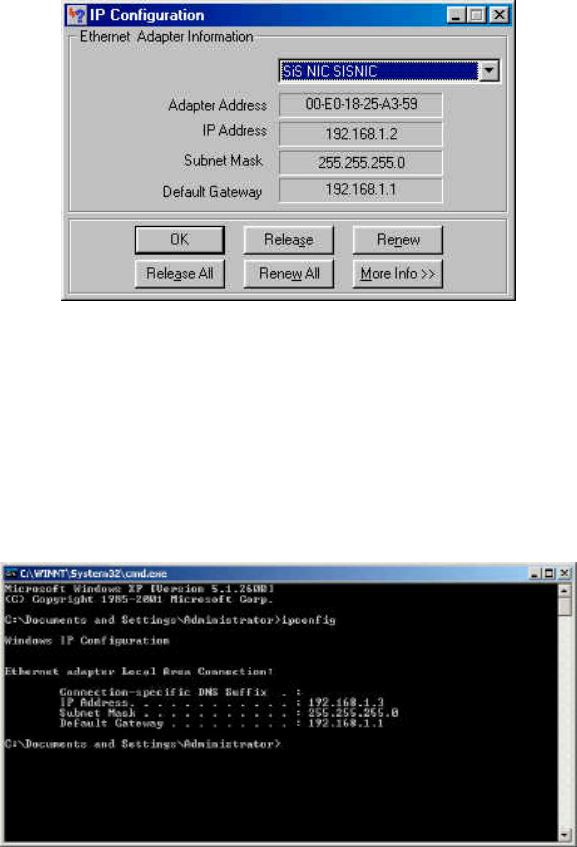
50
gateway is 192.168.1.1. The default gateway should be the network device IP
address. The MAC address in windows 95/98 is called the Adapter Address.
l IPCONFIG (for windows 2000/NT/XP)
In the DOS command type IPCONFIG and press Enter. Your PC IP information will be
displayed as shown below.
This concludes the user manual.
Should you require further assistance or have other inquires please contact your
distributor.

51
Appendix A Specifications
Hardware Specification
Architecture SAMSUNG ARM7 embedded
Operating System supports Supertask
M/B Form Factor 7.5”x5.5”
CPU Support SAMSUNG ARM7
Memory Flash: 1Mbyte
SDRAM: 8Mbyte
Wireless network
architecture
Compatibility: Devices supporting IEEE802.11b wireless
standards
Frequency Band: 2400-2483.4 MHz
Wireless Medium: Direct Sequence Spread Spectrum
Radio data rate: 1, 2, 5.5 and 11Mbps
Modulation:DBPSK@1Mbps,DQPSK@2Mbps,
CCK@5.5 and 11Mbps
Chipset: Intersil PRISM II.5
OperationChannel :
11Channel(America,Canada)
13Channel(Europe)
14 Channel (Japan)
Non-Overlapping channels: 3
Receive Sensitivity:
-88dBm@1Mbps,-86dBm@2Mbps,-84dBm@5.5Mbps, -
80dBm@11Mbps
Output Power: 18-20 dBm max.
Range: 300 feet
Wired Network
architecture . 10/100 Base-T LAN support
Back I/O 4 x 10/100 Base-T LAN Port
2 x Antenna
1 x AC Power Port
52
Appendix B Glossary
Access Point ─ An internetworking device that seamlessly connects wired and wireless networks.
Ad-Hoc ─ An Ad-Hoc wireless LAN is a group of computers each with LAN adapters, connected as an
independent wireless LAN.
Authentication Type ─ Indication of an authentication algorithm which can be supported by this node:
Open System : Open System authentication is the simplest of the available authentication
algorithms. Essentially it is a null authentication algorithm. Any station that requests
authentication with this algorithm may become authenticated if dot11AuthenticationType at the
recipient station is set to Open System authentication.
Shared Key : Shared Key authentication supports authentication of STAs as either a member of
those who know a shared secret key or a member of those who do not.
Open System authentication is the default authentication algorithm.
Backbone ─ The core infrastructure of a network. The portion of the network transports information from
one central location to another central location where it is unloaded onto a local system.
Basic Rate ─ the data rate of the AP with the value 1,2,5.5 or 11 Mbps for your selection.
Bridge ─ An internetworking function that incorporates the lowest 2 layers of the OSI network protocol
model.
BSS ─ BSS stands for “Basic Service Set”. It is an Access Point and all the LAN PCs that associated with
it.
Channel ─ The AP and the with it associated stations will work in this channel. You must set the channel
by consulting Appendix B from violating the Specifications.
DSSS ─ direct sequence spread spectrum
ESS ─ ESS stands for “Extended Service Set”. More than one BSS is configured to become Extended
Service Set. LAN mobile users can roam between different BSSs in an ESS.
ESSID ─ In infrastructure association , the stations will link to the AP with the same ESSID as they have.
Ethernet ─ A popular local area data communications network, originally developed by Xerox Corp., that
accepts transmission from computers and terminals. Ethernet operates on a 10 Mbps base band
transmission rate, using a shielded coaxial cable or over shielded twisted pair telephone wire.
Ethernet IP Address and Subnet Mask ─ Please setup them to match your network environment.
For example: If your IP address is 192.168.99.127 and your Subnet Mask is 255.255.255.0.
Please set the IP address of the AP to 192.168.99.xx which will not have conflict
with other IP address and set the Subnet Mask of the AP to 255.255.255.0.
Ethernet MAC Address ─ Don’t change it, as this will disable the AP.
Infrastructure ─ An integrated wireless and wired LAN is called an Infrastructure configuration.
53
PLCP ─ physical layer convergence protocol
PPDU ─ PLCP protocol data unit
Preamble Type ─ During transmission, the PSDU shall be appended to a PLCP preamble and header to
create the PPDU. Two different preambles and headers are defined : the mandatory supported long
preamble and header which interoperates with the current 1 and 2 Mbps DSSS specification as described in
IEEE Std 802.11-1999, and an optional short preamble and header. At the receiver, the PLCP preamble and
header are processed to aid in demodulation and delivery of the PSDU. The optional short preamble and
header is intended for application where maximum throughput is desired and interoperability with legacy
and non short preamble capable equipment is not consideration. That is, it is expected to be used only in
networks of like equipment that can all handle the optional mode. (IEEE 802.11b standard)
PSDU ─ PLCP service data unit
Roaming ─ A LAN mobile user moves around an ESS and enjoys a continuous connection to the
Infrastructure network.
RTS Threshold ─ Transmitters contending for the medium may not be aware of each other. RTS/CTS
mechanism can solve this “ Hidden Node Problem”. If the packet size is smaller than the preset RTS
Threshold size, the RTS/CTS mechanism will NOT be enabled.
WEP ─ Wired Equivalent Privacy (WEP) is an encryption scheme used to protect wireless data
communication. To enable the icon will prevent other stations without the same WEP key from linking with
the AP.